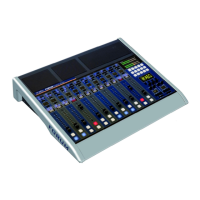AEQ FORUM
Digital audio mixer for broadcast applications
45
• Name of the channel, in alphanumeric format containing up to 6 characters. This is the
same identifier as the one shown in the channel display. See section “2.1.1.3. Channel
display” in this manual.
• Hardware corresponding to the audio input of this channel, in format HW: xx.yy, where
xx is the number of the slot where this inputs/outputs module is installed, and yy is the
audio channel of this inputs/outputs module. In stereo channels, yy represents the audio
channel corresponding to the left channel of the stereo pair. The right channel
corresponds to the number just above.
• Channel typ: mic/líne, analogue or digital.
• Indication of MONO or STEREO signal.
• In mic/line channels, indication of the position of the switch that selects the nominal
level of the signal as mic or line (located in the relevant input module on the back panel
of the unit). It changes from “MIC” to “LINE” and vice versa when you change the switch
position.
• In mic/line channels configured as mic, indication of the position of the phantom power
switch (located in the relevant input module on the back panel of the unit). It changes
from “PHANTOFF” to “PHANTON” and vice versa when you change the switch position.
The contextual keys under the display are associated with the three options shown in the
bottom line of the screen:
• “BACK”: pressing this key allows you to return to the previous menu screen.
• “FADER”: allows you to assign another input channel to the physical fader where this
signal is currently found.
• “ROUTE”: gives you acces to the menu for control and configuration of the internal
routing of the equipment.
3.4.3.1.3.1. “FADER” menu.
This submenu is displayed as a list of all the inputs available in the system (except the ones that
are yet assigned to a fader). You can make your selection by turning any of the associated
encoders and then pressing any of them or the “OK” contextual key to confirm the selection that
is highlighted at that moment.
The “BACK” contextual key allows you to return to the previous menu screen without changed
the assigned signal.
3.4.3.1.3.2. “ROUTE“ menu.
From this internal submenu you can manage the internal routing of signals in the console. You
can access from the advanced information menu of an audio input channel and that submenu
shows an alphabetical list of all of the outputs present in the console, followed by the internal
summing buses (“Program”, “Audition”, “Aux1” and “Aux2”), the monitoring buses (“Cue”,
“Studio” and “Control”) and finally the MPX buses.
The operation of the three associated encoders is as follows:
• Left: turning this encoder allows you to scroll through the several audio outputs and
buses on the list. Pressing this encoder allows you to return to the previous menu
screen (the changes you may have made are saved).
• Centre: turning this encoder has no associated function. Pressing this encoder allows
you to return to the previous menu screen (the changes you may have made are
saved).
• Right: turning this encoder enables you to modify the gain in the cross-point of the
highlighted output or bus between -99.8dB and +12dB. By default, all of the cross-
points will be configured with a 0dB gain. Pressing this encoder allows you to return to
the previous menu screen (the changes you may have made are saved).

